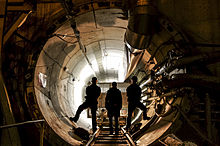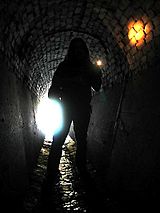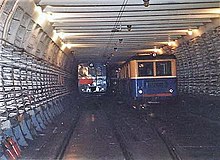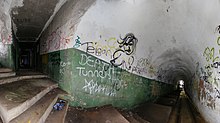利用者:Stepney-I.C.I./sandbox2
en:Urban_exploration oldid=883327565 より翻訳

都市探検 (としたんけん) とは、人工的な構造物(特に廃墟や都市の中で衆目を集めにくい場所)を探検することである。英語の"Urban exploration"の訳語であり、英語圏では"UE"や"urbex"等の略称・呼称も用いられる。写真撮影や歴史的な興味・資料収集は都市探検の中で大きな位置を占めており、必ずしもではないが私有地への不法侵入も都市探検の一部に含まれる場合がある。[1][出典無効] ドレーニング (英:draining、下水道を対象とした都市探検の一種)、都市潜入 (英:urban spelunking)、アーバンロッククライミング (英:urban rock climbing)、ビルディングハッキング (英:building hacking) とも関連付けされる。
都市探検はその性質上様々なリスクを孕んでいる。肉体的な危険がある他、無許可で・あるいは違法に行った場合、逮捕され法的に処罰される恐れがある。都市探検に関連する活動の中には、現地法・地域慣習や広く解釈されている反テロリズム法に違反するものがあり、不法侵入またはプライバシーの侵害とも見なされうる。[2]
対象となる場所[編集]

放棄された建造物[編集]

放棄された建物へ立ち入ることは最も一般的な都市探検の例である。手付かずのまま比較的良好な状態に保たれている場所もあるが、場合によっては地元住民がすでに立ち入っていて、大量の落書きなどを始めとするヴァンダリズム的行為の標的になっている場合もある。都市探検の対象として注目される場所は地域によって異なるが、遊園地・カントリーエレベーター・工場・発電所・ミサイルサイロ・核シェルター・病院・精神病院・学校・救貧院・サナトリウムなどが特に対象とされやすい。
日本では放棄された建造物は廃墟と呼ばれ、欧米における都市探検と共通性が見られる[3]。高度経済成長期の遺産 (例:端島(軍艦島)) の他、太平洋戦争・バブル崩壊・東日本大震災で放棄された建造物が多数存在することから、日本では廃墟は極めてポピュラーな存在である[4]。
都市探検家の多くは、無人の空間が崩壊している様に深い美しさを感じる。一部の探検家は、都市探検で自らが見たものを撮影し、フリーランスの写真家としても活動している。こうした写真家の中には、旧ソ連のインフラ施設を撮影している者もいる。[5]
放棄された場所は都市探検家だけでなく、歴史家、史跡保護活動家、建築家、考古学者、産業考古学者、さらにゴーストハンターにとっても一般的な場所である。
利用中の建造物[編集]
都市探検の別側面として、保安区域または「会員専用」区域、機械室、屋根、エレベーター室、放棄された部屋、その他通常見えない部分へのさまざまな手段による侵入を含む、放棄されていない建造物の探索がある。利用中の建造物を探索することを指して「潜入」(英:infiltration) という言葉がよく利用される。制限区域に侵入すると不法侵入の罪に問われる場合があり、民事訴追される可能性もある。
カタコンベ[編集]

パリ[6]、ローマ、オデッサ、ナポリなどに存在するカタコンベも都市探検の対象とされ続けている。パリの鉱山は、地下坑道のような観光客に開放されていない数々の地下トンネルから成り、その広大さと歴史から『聖杯』と見なされてきた。これらの場所の探検家は「キャタフィル」として知られている。
下水道・雨水管[編集]

雨水管への侵入(ドレーニング)も一般的な都市探検の一種である。オーストラリアのケイブ・クランのようなドレーニングを専門とする探検家のグループも生まれている。ドレーニングには一連の特別なガイドラインがあり、その中でも「雨が降ったら侵入中止」というものが最も重要とされる。 雨が降ると、閉じ込められたり流されたりして死亡する危険性が劇的に高まるからである。
さらに一部の探検家は汚水渠に侵入する。汚水渠は洞窟などの地下構造と唯一繋がっていることがある。 下水道は有毒ガス (多くはメタンと硫化水素) の蓄積による中毒の危険性があるため、探検するのが最も危険な場所の一つである。
交通機関[編集]

Exploring active and abandoned subway and underground railway tunnels, bores, and stations is often considered to be trespassing and can result in civil prosecution, due to security concerns. As a result, this type of exploration is rarely publicized. An important exception to this is the abandoned subway of Rochester, New York, the only American city to have an abandoned, formerly used, subway system. The Cincinnati subway is also abandoned, but was never completed and placed into service. In London, there are a number of stations on the London Underground network that have been closed over the years, with Aldwych tube station being a popular location for explorers.
共同溝[編集]

Universities, and other large institutions such as hospitals, often distribute hazardous superheated steam for heating or cooling buildings from a central heating plant. These pipes are generally run through utility tunnels, which are often intended to be accessible solely for the purposes of maintenance. Nevertheless, many of these steam tunnels, especially those on college campuses, often also have a tradition of exploration by students. This practice was once called "vadding" at the Massachusetts Institute of Technology, though students there now refer to it as roof and tunnel hacking.
Some steam tunnels have dirt floors, poor lighting and temperatures upwards of 45 °C (113 °F). Others have concrete floors, bright light, and more moderate temperatures. Most steam tunnels have large intake fans to bring in fresh air and push the hot air out the back, and these fans may start without warning. Most active steam tunnels do not contain airborne asbestos, but proper breathing protection may be required for other respiratory hazards. Experienced explorers are very cautious inside active utility tunnels, since pipes can spew boiling hot water or steam from leaky valves or pressure relief blowoffs. Frequently there are puddles of muddy water on the floor, making slips and falls a special concern near hot pipes.
Steam tunnels have generally been secured more heavily in recent years, due to their frequent use for carrying communications network backbone cables, increased safety and liability concerns, and perceived risk of their use in terrorist activities.
知名度[編集]
The rise in the popularity of urban exploration can be attributed to its increased media attention. Recent television shows, such as Urban Explorers on the Discovery Channel, MTV's Fear, and the Ghost Hunting exploits of The Atlantic Paranormal Society have packaged the hobby for a popular audience. The fictional film After... (2006), a hallucinatory thriller set in Moscow's underground subways, features urban explorers caught up in extreme situations. Talks and exhibits on urban exploration have appeared at the fifth and sixth Hackers on Planet Earth Conference, complementing numerous newspaper articles and interviews.
Another source of popular information is Cities of the Underworld, a documentary series which ran for three seasons on the History Channel, starting in 2007. This series roamed around the world, showing little-known underground structures in remote locales, as well as right under the feet of densely packed city-dwellers.
With the rise in the relative popularity of the hobby due to this increased focus, there has been increasing discussion on whether the extra attention has been beneficial to urban exploration as a whole. The unspoken rule of urban exploring is "take nothing but photographs, leave nothing but footprints", but because of the rising popularity, many individuals who may have other intentions are creating a concern among many property owners.
安全性と合法性[編集]

Urban exploration is a hobby that comes with a number of inherent dangers. For example, storm drains are not designed with human access as their primary use. They can be subject to flash flooding and bad air. There have been a number of deaths in storm water drains, but these are usually during floods, and the victims are normally not urban explorers.[7]
Many old abandoned structures feature hazards such as unstable structures, unsafe floors, broken glass, the presence of unknown chemicals and other harmful substances (most notably asbestos), stray voltage, and entrapment hazards. Other risks include freely roaming guard dogs and hostile squatters. Some abandoned locations may be heavily guarded with motion detectors and active security patrols, while others are more easily accessible and carry less risk of discovery.[8]
Asbestos is a long-term health risk for urban explorers, along with breathing in contaminants from dried bird feces, which can cause a condition known as pigeon-breeder's lung, a form of hypersensitivity pneumonitis. Urban explorers may use dust masks and respirators to alleviate this danger. Some sites are occasionally used by substance abusers for either recreation or waste disposal, and there may be used or infected syringe needles en route, such as those commonly used with heroin.
The growing popularity of the activity has resulted not just in increased attention from explorers, but also from vandals and law enforcement. The illicit aspects of urban exploring, which may include trespassing and breaking and entering,[9] have brought along with them critical articles in mainstream newspapers.[10]
In Australia, the website of the Sydney Cave Clan was shut down by lawyers for the Roads and Traffic Authority of New South Wales, after they raised concerns that the portal could "risk human safety and threaten the security of its infrastructure".[10] Another website belonging to the Bangor Explorers Guild was criticized by the Maine State Police for potentially encouraging behavior that "could get someone hurt or killed".[10] The Toronto Transit Commission has used the Internet to crimp subway tunnel explorations, going as far as to send investigators to various explorers' homes.[10]
Jeff Chapman, who authored Infiltration, stated that genuine urban explorers "never vandalize, steal or damage anything". The thrill comes from that of "discovery and a few nice pictures".[10] Some explorers will also request permission for entry in advance.[11]
ルーフトッピング[編集]

"Rooftopping" refers to the ascent of rooftops, cranes, antennas, smokestacks, etc., usually illegally, and for the purpose of getting an adrenaline rush and taking selfie photos or videos and panoramic photographs of the scene below.[12] It has been especially popular in Russia.[13]
写真資料[編集]
Many urban explorers adhere to the philosophy of cave explorers and outdoors hikers: "Take nothing but pictures. Leave nothing but footprints."[14] Some are photographers who specialize in documenting urban ruins and scenes of industrial decay. Professional photographers working in this field include Julia Solis, Rebecca Lilith Bathory Johnny Joo, Seph Lawless, and Andrew L. Moore. Other well-known photographers, such as Jan Saudek, use the interiors of abandoned buildings as backdrops for their figurative and portrait works.
利用技術[編集]
Some urban explorers use head-cams such as GoPro or other helmet cameras for videos.[15][16][17]
Some also use quadcopter drones for exploration and recording.[18][16]
The location-based games Ingress[19] and the following Pokémon Go[20][21] based on the former have urban exploration elements. While some are concerned with keeping certain sites secret from the public at large, mainly to prevent vandalism, several apps dedicated to urban exploration exist.[22][23]
現代文化での扱い [編集]
Template:In popular culture Urban exploration is featured in a number of works, in a variety of media, such as:
文学[編集]
- Johnny Joo's book series on abandoned places across the United States, including Empty Spaces (2014), Americana Forgotten (2016) and Unbuilt by Time (2017)
- Rebecca Bathory's photography book's on abandoned places around the world, including Soviet Ghosts (2014), Fukushima (2017) and Orphans of Time (2017)
- Bradley L. Garrett's work of nonfiction, Explore Everything: Place-Hacking the City (2013)
- John Green's novel Paper Towns (2008)
- In James Rollins' Sigma Force novel 6.5, The Skeleton Key (2010), cataphile and urban explorer Renny MacLeod, who has tattooed the Paris Catacombs on his body, is kidnapped and forced to guide former Guild member Seichan to find and save the kidnapper's son, who is scheduled be sacrificed, at noon, by the Order of the Solar Temple.[24]
テレビ番組[編集]
- VICELAND premiered ABANDONED on 2 September 2016, a series hosted by skateboarder Rick McCrank about abandoned places and the people who love them.
- Red Bull TV launched URBEX – Enter At Your Own Risk on 1 August 2016, an 8-part series about the motivations, mindsets, and adventures of urban explorers.[25]
- Travel Channel aired Off Limits (2011–2013), a series based on urban exploration hosted by Don Wildman.
- Unforgettable's "Maps and Legends" (season 2, episode 7) featured urban exploration.
- Discovery Channel briefly ran Urban Explorers (2005), a series based on urban exploration hosted by urban explorer Steve Duncan.
その他[編集]
- stalkers - subculture of urban exploration in Russia and Ukraine. The name comes from the novel Roadside Picnic.
- diggers (ru:Диггерство) - an alternative subculture of urban exploration in Russia and Ukraine
- rural exploration, or rurex - similar to urban exploration but often taking place in rural settings
関連項目[編集]
- Caving
- C.H.U.D.
- Dead malls
- Eastern State Penitentiary
- Freedom Tunnel
- Ghost town
- Legend tripping
- les UX
- Miru Kim – artist who documents urban explorations
- Modern ruins
- MONU – magazine on urbanism
- Morlock
- Ohio Penitentiary
- Parkour
- Psychogeography
- Reality hacking
- Rebecca Lilith Bathory – artist who documents urban explorations
- Roof and tunnel hacking
- Ruins photography
- Six Flags New Orleans
- Trespass
- Urban decay
- Utility tunnel
- Weird New Jersey
- Wreck diving
- 稼働遺産(新規追加)
- インフラツーリズム(新規追加)
出典[編集]
- ^ Nestor, James (2007年8月19日). “The Art of Urban Exploration”. San Francisco Chronicle 2008年6月20日閲覧。
- ^ Haeber, Jonathan (2008年12月21日). “Complete Guide to Urban Exploration”. Bearings 2009年9月30日閲覧。
- ^ Gakuran, Michael. “The Hazards of Haikyo and Urban Exploration”. 2011年6月21日閲覧。
- ^ “Haikyo: Abandoned Treasure”. Weekender (2010年5月). 2010年11月18日閲覧。
- ^ Shevchenko, Vitaly (2014年2月11日). “The urban explorers of the ex-USSR”. BBC 2014年2月12日閲覧。
- ^ Paris Underground Map (Map). Michel-Eugène Lefébure de Fourcy. 1841.
- ^ “Boy, 14, drowns in drain during heavy rains”. GNA. (2007年6月4日) 2008年8月9日閲覧。
- ^ Owen, Mary (2004年12月5日). “Abandoned beauties: Urban explorers find adventure in ruins of old buildings”. U-T San Diego 2009年7月27日閲覧。
- ^ “Urban exploration - Richard Shepherd photographs derelict buildings in the North East and further afield.”. BBC Tyne, Broadcasting Centre (2008年8月20日). 2014年4月23日閲覧。
- ^ a b c d e Batz Jr., Bob (2003年9月7日). “Urban explorers dare to investigate seldom-seen Pittsburgh sites”. Pittsburgh Post-Gazette 2008年6月20日閲覧。
- ^ Ebaster, Al (2007年9月19日). “Legal Urban Exploration: 7 Tips for Visiting Historical Abandonments”. Web Urbanist
- ^ “Meet the rooftoppers: the urban outlaws who risk everything to summit our cities”. The Guardian. Template:Cite webの呼び出しエラー:引数 accessdate は必須です。
- ^ Lucy Ash, Article in "BBC News" March 23, 2017
- ^ “Motto of the Baltimore Grotto (caving society)”. The Quotations Page. QuotationsPage.com. 2014年3月28日閲覧。
- ^ “Afraid of heights? You’ll still want to watch this”. Red Bull. 2017年2月11日閲覧。
- ^ a b “The Hong Kong urban adventurers for whom nothing is too tall, or deep, or spooky” (英語). South China Morning Post. 2017年2月11日閲覧。
- ^ “Meet the Place Hackers”. Time (magazine). 2017年2月11日閲覧。
- ^ “Using Stealth, and Drones, to Document a Fading Hong Kong”. The New York Times (2017年2月7日). 2017年2月11日閲覧。
- ^ Harris, Jesse (英語). The Practical Guide to Ingress: What you really need to know without the extraneous junk. Jesse Harris 2017年2月11日閲覧。
- ^ “Why Pokémon Go will surprise you in your own city” (英語). Newsweek. 2017年2月11日閲覧。
- ^ “Pokémon Go - A New Avenue for Urban Exploration » CSBE”. Center for the Study of the Built Environment. 2017年2月12日時点のオリジナルよりアーカイブ。2017年2月11日閲覧。
- ^ “5 Apps That Help You Find Your City's Hidden Gems”. Gizmodo. 2017年2月12日閲覧。
- ^ “Abandoned App Leads You to Local Urban Exploration Sites”. WebUrbanist (2013年2月26日). 2017年2月12日閲覧。
- ^ Rollins, James (2010年). “What's True, What's Not”. The Skeleton Key: pp. 1–2
- ^ “The ultimate selfie! Daredevils show no fear chasing the perfect shot”. 2016年8月11日閲覧。
参考文献 [編集]
- Timothy Hannem, Urbex : 50 lieux secrets et abandonnés en France, Arthaud, ISBN 978-2081356078
- Garrett, Bradley L. (October 2013). Explore Everything: Place-Hacking the City. Verso Books, Brooklyn, London and Paris. ISBN 9781781681299 2014年4月23日閲覧。
- Gates, Moses (2012). Hidden Cities: Travels to the Secret Corners of the World's Great Metropolises; A Memoir of Urban Exploration Tarcher, New York. ISBN 978-1585429349
- Lyden, Jacki (2013年9月14日). “New York Underground: Exploring City Caves and Catacombs”. All Things Considered (NPR)
- Margaine, Sylvain (2009) Forbidden Places: Exploring Our Abandoned Heritage (Hardcover), ISBN 2-915807-82-5
- Ninjalicious (2005). Access All Areas: A user's guide to the art of urban exploration. PO Box 13, Station E, Toronto, ON M6H 4E1 Canada: Infilpress. ISBN 0-9737787-0-9
- Paiva, Troy (2008) Night Vision: The Art of Urban Exploration Chronicle Books ISBN 0-8118-6338-7
- Melody Gilbert's Urban Explorers: Into the Darkness (2007), a documentary about some of the world's urban explorers.
外部リンク[編集]
 ウィキメディア・コモンズには、Stepney-I.C.I./sandbox2に関するカテゴリがあります。
ウィキメディア・コモンズには、Stepney-I.C.I./sandbox2に関するカテゴリがあります。 ウィキボヤージュには、Urban explorationに関する旅行情報があります。
ウィキボヤージュには、Urban explorationに関する旅行情報があります。
